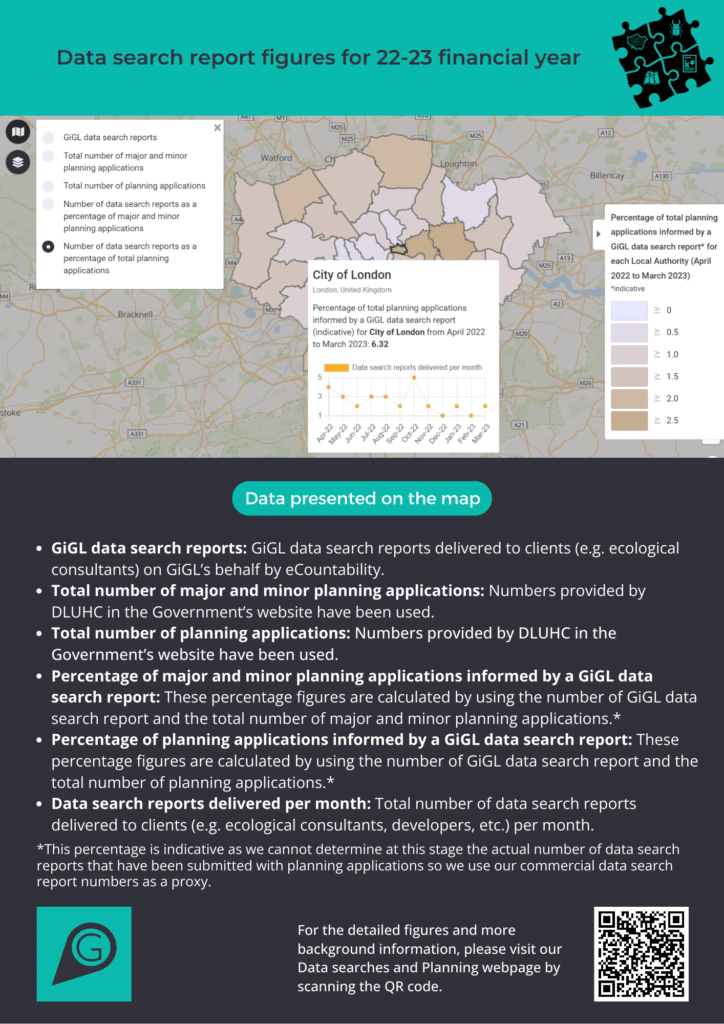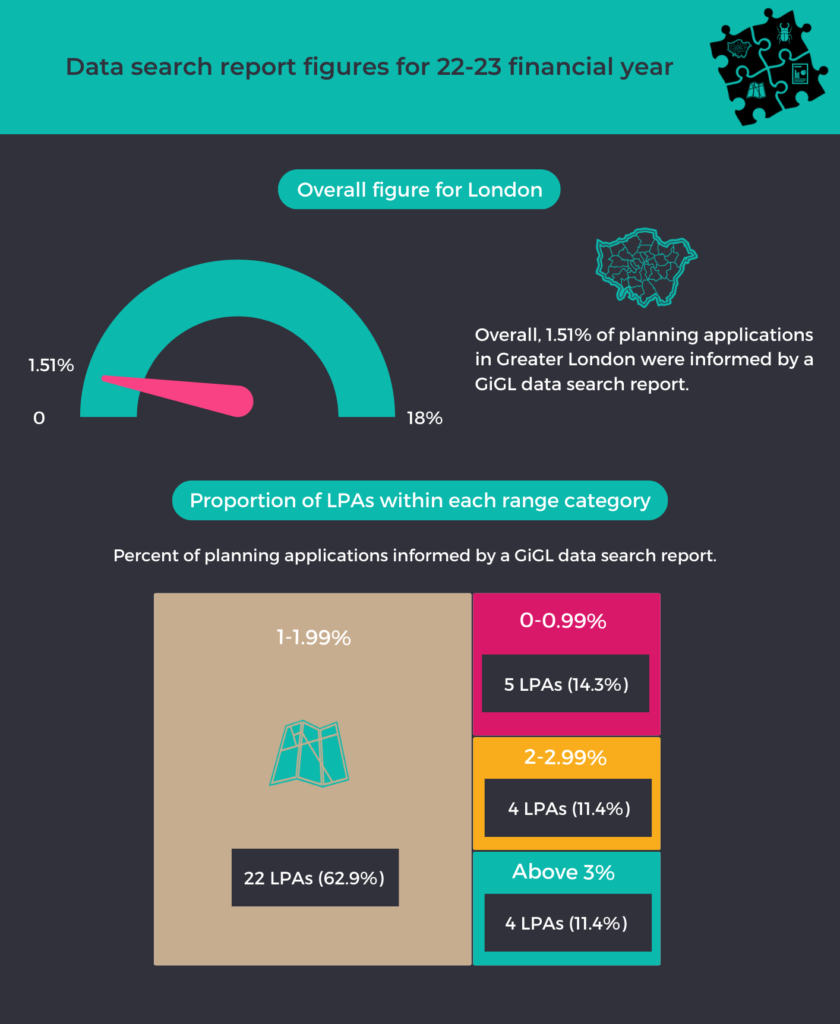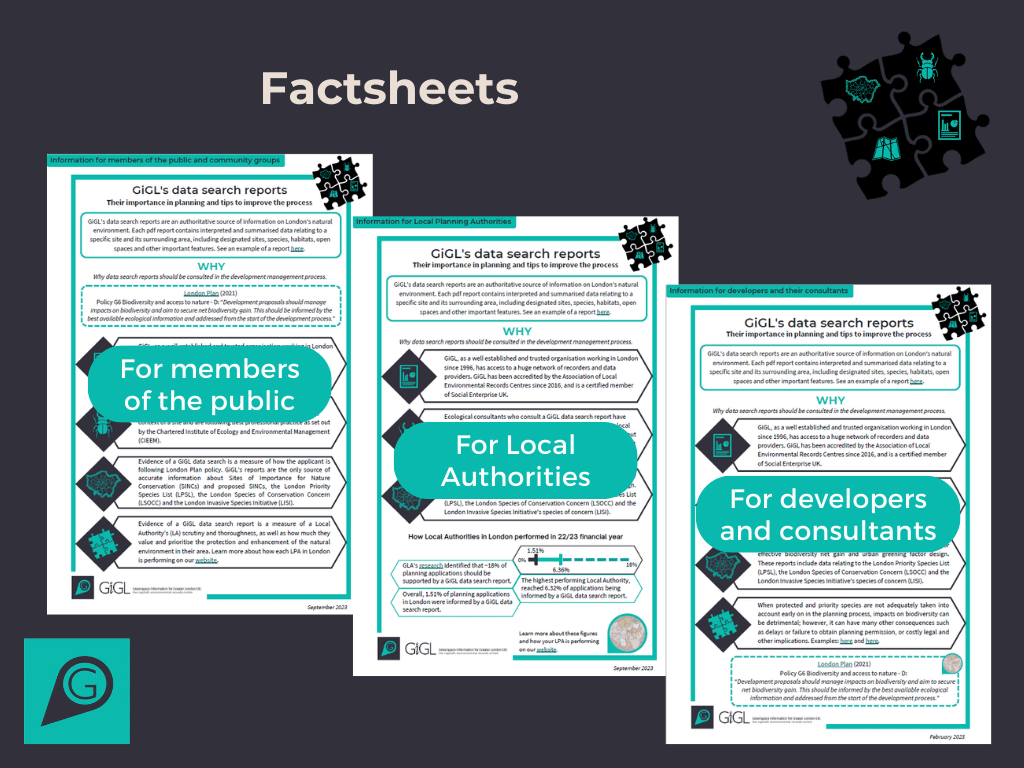New data search report figures and resources
In May 2022 we published a GiGLer article re-introducing our data search reports and presenting our new interactive map that shows data search report figures per Local Authority. We suggest you read the article for an overview of our data search reports and their importance in planning. We’re also happy to announce that we have just launched a series of data search report updates which you can read all about here. In this article we will be covering the updated figures we recently published and what they can tell us about planning in London, and introduce some newly launched resources.
The updated figures on our Data Searches and Planning webpage give information on planning applications informed by GiGL data search reports in each Local Authority, which provide an indication of how well (or not) biodiversity data are used to inform development in London. The interactive map now shows the figures for the 2022-23 financial year. There are five layers presenting different data and pop up boxes which include monthly data search numbers for each Local Authority.

We update these figures on our website on an annual basis following the project by the Mayor of London (2016) which concluded that about 18% of planning applications in a one year period in London should have been supported by a GiGL data search report, however only 1% of applications that were validated were actually informed by one during the same period.
Our numbers indicate a slight increase from 1.43% in the 2021 calendar year and 1.5% in the 2021-22 financial year to 1.51% of planning applications in Greater London informed by a GiGL data search report in the 2022-23 financial year. The individual Local Authority numbers range from 0.51% to 6.32% of planning applications informed by a GiGL data search report. The two London Mayoral Development Corporations’ (London Legacy Development Corporation and Old Oak and Park Royal Development Corporation) percentages are higher but they are unique in that they receive a considerably lower number of planning applications compared to the rest of London’s Local Planning Authorities[1] (LPAs). Overall, the majority of LPAs (22 LPAs) had between 1% and 1.99% of planning applications informed by a data search report. We are a long way away from the ideal 18% but there are some Local Authorities that are doing better than others.
[1] There are 35 Local Planning Authorities in London; this includes the 32 boroughs, the City of London and the two Mayoral Development Corporations, London Legacy Development Corporation (LLDC) and Old Oak and Park Royal Development Corporation (OPDC)

The London Plan’s (2021) policy G6 on Biodiversity and access to nature (D) states that “Development proposals should manage impacts on biodiversity and aim to secure net biodiversity gain. This should be informed by the best available ecological information and addressed from the start of the development process”. With the climate and ecological emergencies and new requirements such as biodiversity net gain (BNG), urban greening and nature recovery it is important that decisions are informed by a robust evidence base. This includes decisions made by developers when designing and planning their development project but also the decisions made by Local Authorities when reviewing planning applications. So, how can we all do better and increase the percentages shown above?
One of the highest scoring LPAs believes that their higher numbers could be attributed to an increase in the number of developments applying the Urban Greening Factor requirement as this needs to be informed by a GiGL data search report. The Urban Greening Factor is a London Plan policy and local authorities are incorporating relevant policies in their new Local Plans. Another LPA which saw a considerable increase in their number from previous years believes that this could be due to an updated validation checklist referring to the requirement for a data search report, improved validation processes and increased in-house ecological capacity providing planning advice.
GiGL would like to continue supporting this process and inform our stakeholders about the importance of our data search reports in planning. We have updated our Planning for Nature webpage making it easier to find the right information in the associated subpages. We have also added three associated pages:
- Natural Environment Data in Planning with information on the importance of natural environment data informing the development management process including relevant references to polices and guidance.
- Data Sharing from Development with information on how the planning process can enhance the existing evidence base in order to enable better decisions in the future.
- Biodiversity net gain with information on what GiGL has been doing to prepare for BNG and our plans for the future.
We hope that various stakeholders will find the information in these webpages useful. We will keep updating them with new information as new relevant legislation and guidance becomes available.
We have also produced a series of factsheets for different stakeholders with relevant information on the importance of our data search reports and tips on how to ensure the existing evidence base is consulted and enhanced at each phase of development management[1]. We hope to empower our stakeholders with the right information to support better decision-making and ultimately achieve better outcomes for biodiversity in London.
[1] Development management definition: “Development Management, formerly known as planning control, or development control, is the element of the United Kingdom’s system of town and country planning through which local government or the Secretary of State, regulates land use and new building, i.e. development.”. (Source: https://en.wikipedia.org/wiki/Development_management_in_the_United_Kingdom, accessed 04/09/2023)


Eleni, the factsheets look really helpful. I’m surprised that so few developers have been carrying out a GiGL search. Are LPAs providing guidance to applicants encouraging or requiring them to undertake a search in relevant circumstances?
Hi Malcolm. I’m glad that you like the factsheets. Some local authorities mention the data search reports in their validation checklists and planning application requirement documents. Others are currently in the process of incorporating it in their local policies. Following up with developers when the appropriate information is not included with planning applications, is another important part of the process. We are always trying to raise awareness of the importance of informed, evidence-based decision making with data search reports being an important aspect of this. We are currently doing a series of sessions with planners on this subject and biodiversity net gain. For more information please do get in touch.